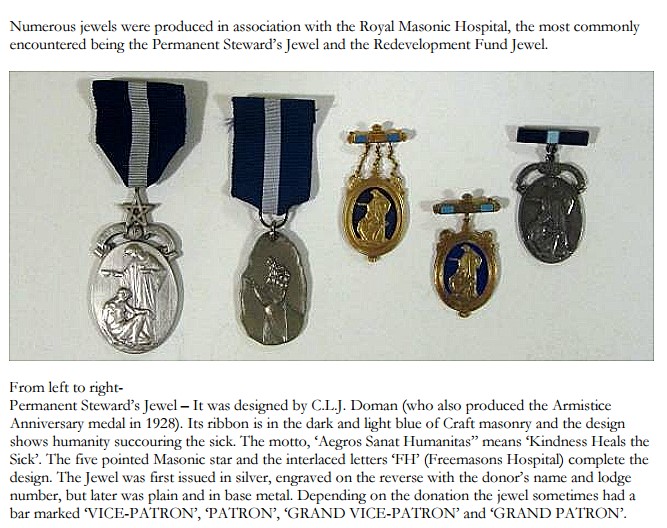En: Royal masonic Hospital
Royal masonic Hospital
In 1911, members of Malmesbury Lodge No. 3156 became interested in the possibility of starting a Masonic hospital or nursing home and formed a committee with a civil engineer, Percy Still, as secretary. In 1913 Grand Lodge approved the idea and by 1916 fundraising had begun. The spiralling number of Great War casualties moved supporters of the hospital scheme to take out a short term lease of the former Chelsea Woman’s Hospital in Fulham Road, London and open it as the Freemasons’ War Hospital. Over 4,000 servicemen were treated at the hospital by the end of the war.
Additional facilities were opened at Fulham Palace and a convalescent home was opened in Caversham near Reading After World War I the Freemason’s Hospital and Nursing Home opened in the Fulham Road premises and accepted its first patient in 1920. Despite alterations this site proved too small and supporters continues their efforts to find a larger site. Once sufficient funds were secured a site was purchased at Ravenscourt Park, West London. In 1933, King George V and Queen Mary opened the hospital and the King granted permission for it to be known as the Royal Masonic Hospital. Money for the hospital was raised through donations, with donors being awarded a special jewel, known as the Permanent Steward’s Jewel.
During the Second World War the hospital again became a war hospital, treating over 8,600
servicemen, at no cost to the government. After the war, the formation of the National Health Service
saw the end of many private hospitals but the Royal Masonic Hospital remained independent. A School
of Nursing was established in 1948 and it quickly gained a reputation for producing highly skilled
nurses, whose distinctive silver belt buckles became a coveted honour amongst the profession.
By the late 1970s approximately 4,700 patients per year were being treated. Although patients were
mostly freemasons, fee paying non-members were accepted from 1977. In 1976 the Grand Master, the
Duke of Kent, opened the Percy Still wing, with four new operating theatres. However, fewer masons
wanted to travel to London for treatment and running costs grew rapidly due to inflation. In 1992
Grand Lodge recommended that it’s closure to safeguard its assets. In 2002, the hospital buildings were
acquired by the Hammersmith Hospitals NHS Trust as Ravenscourt Park Hospital, to relieve bed
shortages.
Permanent Steward’s Jewel – It was designed by C.L.J. Doman (who also produced the Armistice Anniversary medal in 1928). Its ribbon is in the dark and light blue of Craft masonry and the design shows humanity succouring the sick. The motto, ‘Aegros Sanat Humanitas” means ‘Kindness Heals the Sick’. The five pointed Masonic star and the interlaced letters ‘FH’ (Freemasons Hospital) complete the design. The Jewel was first issued in silver, engraved on the reverse with the donor’s name and lodge number, but later was plain and in base metal. Depending on the donation the jewel sometimes had a bar marked ‘VICE-PATRON’, ‘PATRON’, ‘GRAND VICE-PATRON’ and ‘GRAND PATRON’. Redevelopment Fund Jewel – This jewel was issued to those who subscribed £12 or more to the Assistant Grand Master’s Redevelopment Fund to build the 1956 extension to the hospital. Those who already had the hospital jewel were given a bar to wear with it rather than this jewel. The jewel was the concept of Leslie Durbin, M.V.O. LL.D., artist and silversmith. It shows a detail of a hand from a painting by the artist Botticelli. Earlier versions had wording on the reverse but this was later omitted. Jewel for ladies who became Life Governors in 1932, at the hospital’s opening, incorporating the image from the Permanent Steward’s Jewel. The bar monogram is ‘FH’ for ‘Freemason’s Hospital’ as the building had not yet been granted its royal title. The jewel is made from multiple parts and is 9ct gold. Jewel for lady patrons after the opening of the hospital. Generally similar to the above, but this is a single casting in silver gilt and enamel, with the monogram changed to ‘RMH’, for ‘Royal Masonic Hospital’. Other versions of this jewel and the one described above exist with slight variations. Nurses’ issue jewel with an enamelled bar rather than a ribbon to make it suitable for wear with a uniform, incorporating the image from the Permanent Steward’s jewel.
© The Library and Museum of Freemasonry (Registered Charity No 1058497) 2010
www.freemasonry.london.museum

